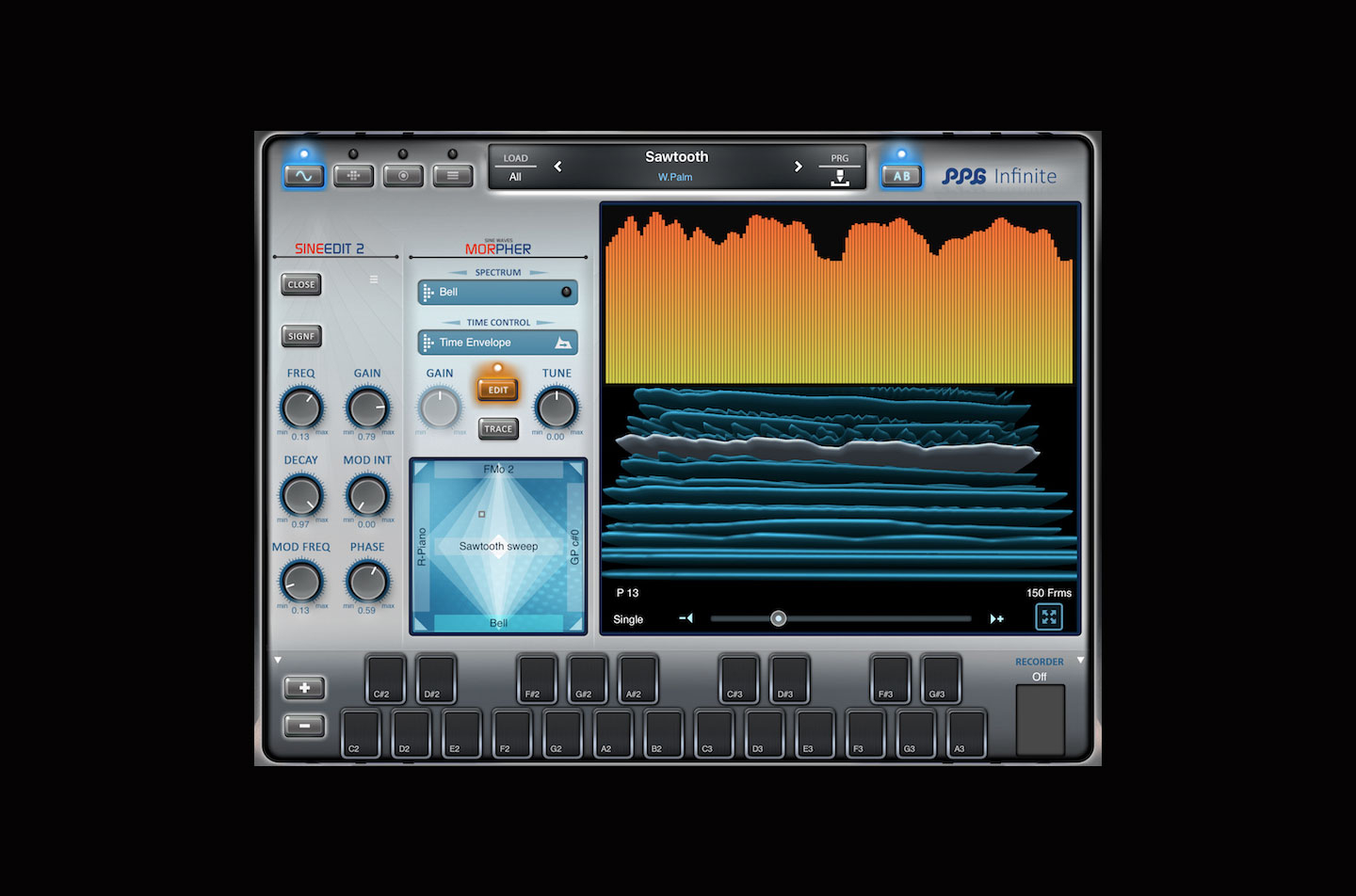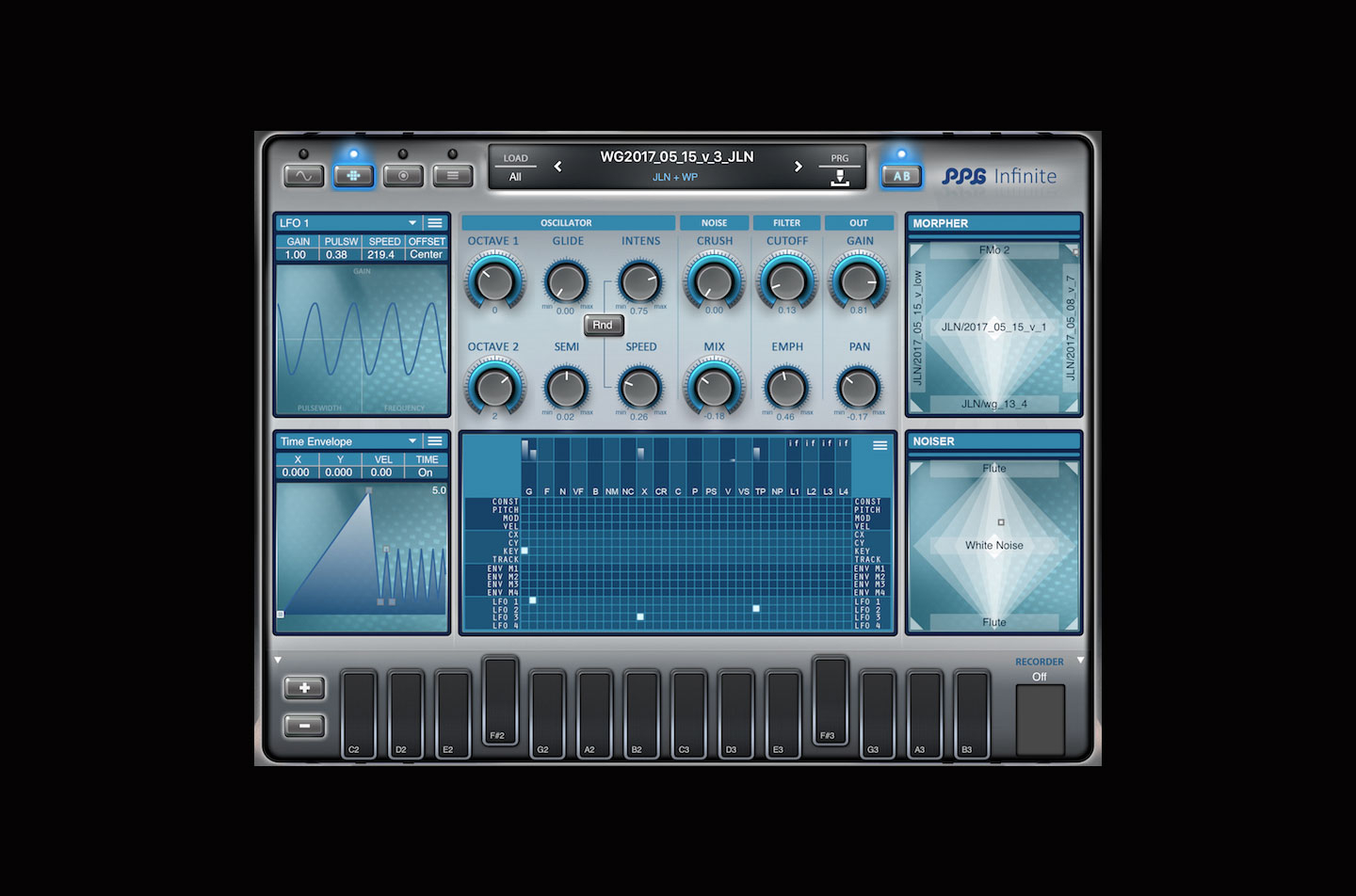- Wolfgang Palm spent the late '70s breaking new ground in the field of wavetable synthesis. His work laid the foundation for revolutionary instruments like the PPG Wave and the Waldorf Microwave, which provided many of the trademark sounds of '80s new wave and experimental music. More recently, he's made a brand new set of iOS instruments that innovate further. He and his team have developed apps that let you draw your own wavetables or transform pictures into sound (WaveGenerator), create them from audio sample analysis (WaveMapper) or mimic the physical attributes of the human voice (Phonem). Palm proved he still has more ideas when he recently revealed perhaps his most ambitious project yet: PPG Infinite.
Unlike Palm's other apps, Infinite is not designed to create wavetables from scratch. Rather, it's meant to provide new ways to play and transform existing wavetables. It ships with over 300 of these tonal resources. More importantly, you can also import your own sounds from the aforementioned iOS apps. At the iOS app price point, this limitation is well within the bounds of what's reasonable.
On the PPG Infinite web page, Palm calls Infinite his "dream. A system which can reproduce all kinds of sounds and… all these sounds are completely morphable." The page also details the limitations of reproducing natural sounds with normal wavetable synthesis techniques, thanks to the fact that all partials are harmonic. PPG designed Infinite to be able to overcome this by giving users the ability to freely transform or modulate the frequency of individual partials within a chosen wavetable. This is the bread and butter of Infinite: having detailed control over the individual components within a single wavetable while being able to morph between multiple, sculpted wavetables.
If it sounds complicated, that's because it is. It's clear when you first open the app and take in the breadth of the UI, which is a space-age affair complete with the esoteric look and feel of the other PPG apps. Everything begins on the main morphing page, which houses three panels. The first of these is the morpher panel, which is where you can select up to five different wavetables within the X/Y axis. Here the X direction morphs between the gains (volumes) of the wavetables and the Y direction handles the frequencies. It's a design that's not necessarily obvious and takes a bit of time to get used to. The active point within the X/Y control can either be controlled via touch or modulated using Infinite's modulation matrix.
The morpher wavetable oscillator in Infinite is the main tone source. There's also a sub oscillator and a noise source that uses a second X/Y controller to mix between three different noise spectrums. Both of these have advanced features. The sub can be configured to play a different wavetable by using one of the alternative routing algorithms, and the noise oscillator can be used to modulate the main oscillator by using the X direction on its controller. From the oscillators the signal passes into the "molder," a filter engine that provides a mixture of classic filter types as well as tonal filter wavetables imported from Phonem or generated by PPG to model physical sounds. There is a whole selection of presets that showcase this feature, using noise or rezzy oscillators to produce words or entire phrases. Finally, the signal also passes through a series of effects, which include bit-crushing, drive, reverb and delay.
On the left edge of the main page you'll find buttons that open Infinite's four waveform views, each centred around 3D representations of the sound's partials. The first two, SINE 1 and SINE 2, allow you to alter these partials by adjusting the frequency, gain and decay, as well as apply modulation to them individually or together. SINE 2 also lets you draw in the gain and frequency of an individual partial, which gets to the heart of what makes PPG unique. The RND view lets you apply various levels of randomisation to the same set of parameters. This ability to modulate and alter individual partials of a sound in real time is something I've never seen before. The fact Wolfgang and crew achieved it within an iPad instrument is pretty astonishing.
The trade-off to Infinite's vast power is a steep learning curve. While some aspects of the UI are impressive (such as the 3D display), in many cases it's just plain confusing. More than once, I found myself having to dive into the menu to try to figure out what the instrument was doing, and often it took a trip through multiple panels and dropdown menus to fully understand a patch. But if you're willing to read the manual and spend the time learning the instrument, you'll be able to make sounds that wouldn't be possible on anything else out there today. For that alone, it's well worth the price of admission.
Ratings:
Cost: 4.8
Versatility: 4.6
Ease of use: 3.0
Sound: 4.2
 On the left edge of the main page you'll find buttons that open Infinite's four waveform views, each centred around 3D representations of the sound's partials. The first two, SINE 1 and SINE 2, allow you to alter these partials by adjusting the frequency, gain and decay, as well as apply modulation to them individually or together. SINE 2 also lets you draw in the gain and frequency of an individual partial, which gets to the heart of what makes PPG unique. The RND view lets you apply various levels of randomisation to the same set of parameters. This ability to modulate and alter individual partials of a sound in real time is something I've never seen before. The fact Wolfgang and crew achieved it within an iPad instrument is pretty astonishing. The trade-off to Infinite's vast power is a steep learning curve. While some aspects of the UI are impressive (such as the 3D display), in many cases it's just plain confusing. More than once, I found myself having to dive into the menu to try to figure out what the instrument was doing, and often it took a trip through multiple panels and dropdown menus to fully understand a patch. But if you're willing to read the manual and spend the time learning the instrument, you'll be able to make sounds that wouldn't be possible on anything else out there today. For that alone, it's well worth the price of admission. Ratings: Cost: 4.8 Versatility: 4.6 Ease of use: 3.0 Sound: 4.2
On the left edge of the main page you'll find buttons that open Infinite's four waveform views, each centred around 3D representations of the sound's partials. The first two, SINE 1 and SINE 2, allow you to alter these partials by adjusting the frequency, gain and decay, as well as apply modulation to them individually or together. SINE 2 also lets you draw in the gain and frequency of an individual partial, which gets to the heart of what makes PPG unique. The RND view lets you apply various levels of randomisation to the same set of parameters. This ability to modulate and alter individual partials of a sound in real time is something I've never seen before. The fact Wolfgang and crew achieved it within an iPad instrument is pretty astonishing. The trade-off to Infinite's vast power is a steep learning curve. While some aspects of the UI are impressive (such as the 3D display), in many cases it's just plain confusing. More than once, I found myself having to dive into the menu to try to figure out what the instrument was doing, and often it took a trip through multiple panels and dropdown menus to fully understand a patch. But if you're willing to read the manual and spend the time learning the instrument, you'll be able to make sounds that wouldn't be possible on anything else out there today. For that alone, it's well worth the price of admission. Ratings: Cost: 4.8 Versatility: 4.6 Ease of use: 3.0 Sound: 4.2